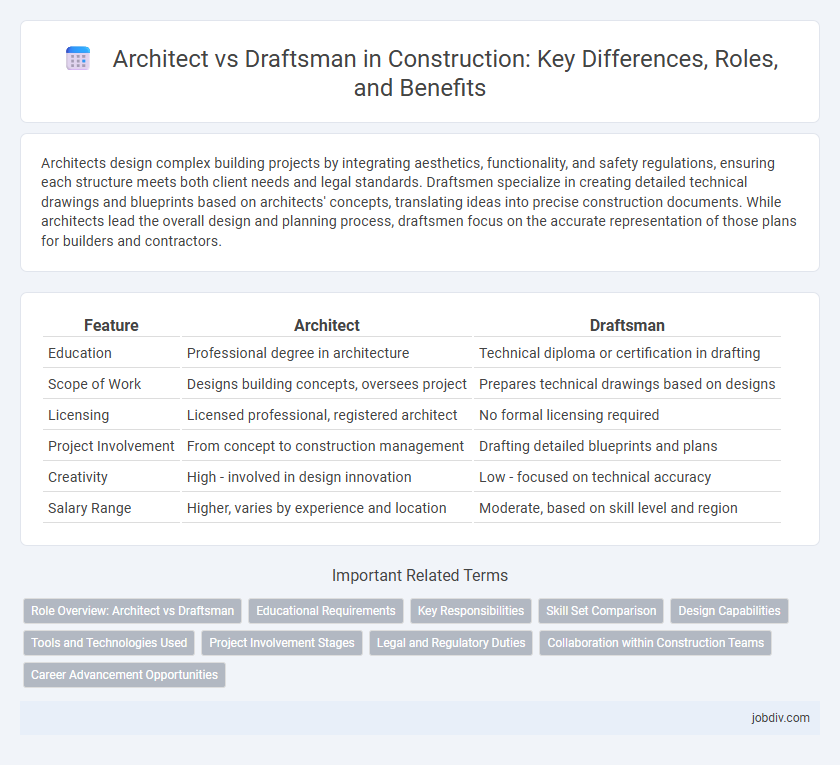Architects design complex building projects by integrating aesthetics, functionality, and safety regulations, ensuring each structure meets both client needs and legal standards. Draftsmen specialize in creating detailed technical drawings and blueprints based on architects' concepts, translating ideas into precise construction documents. While architects lead the overall design and planning process, draftsmen focus on the accurate representation of those plans for builders and contractors.
Table of Comparison
| Feature | Architect | Draftsman |
|---|---|---|
| Education | Professional degree in architecture | Technical diploma or certification in drafting |
| Scope of Work | Designs building concepts, oversees project | Prepares technical drawings based on designs |
| Licensing | Licensed professional, registered architect | No formal licensing required |
| Project Involvement | From concept to construction management | Drafting detailed blueprints and plans |
| Creativity | High - involved in design innovation | Low - focused on technical accuracy |
| Salary Range | Higher, varies by experience and location | Moderate, based on skill level and region |
Role Overview: Architect vs Draftsman
An architect is responsible for designing buildings and overseeing the entire construction process, ensuring compliance with regulations, aesthetics, and functionality. A draftsman specializes in creating detailed technical drawings and blueprints based on the architect's designs, focusing on accuracy and specifications for contractors. Architects require a professional license and typically handle project management, while draftsmen provide essential support through precise documentation.
Educational Requirements
Architects require a professional degree in architecture, such as a Bachelor or Master of Architecture, followed by mandatory internship hours and licensing exams to practice legally. Draftsmen typically need a certificate or associate degree in drafting or CAD technologies, with emphasis on technical skills rather than formal licensing. The contrasting educational pathways reflect the architect's broader responsibilities in design theory and project management versus the draftsman's focus on technical drawing execution.
Key Responsibilities
Architects lead the overall design process, creating detailed plans, ensuring code compliance, and managing project vision and client collaboration. Draftsmen specialize in producing precise technical drawings and blueprints based on architects' designs, focusing on accuracy and construction specifications. While architects handle design innovation and regulatory approval, draftsmen transform concepts into executable visual documents for builders.
Skill Set Comparison
Architects possess advanced design skills and comprehensive knowledge of building codes, structural integrity, and project management, enabling them to create functional and aesthetically pleasing structures. Draftsmen specialize in technical drawing and detailed blueprints using CAD software, translating architects' concepts into precise construction documents. While architects focus on conceptualization and regulation compliance, draftsmen excel in technical accuracy and documentation for construction teams.
Design Capabilities
Architects possess advanced design capabilities, blending creativity with technical knowledge to develop comprehensive building plans that meet aesthetic, functional, and regulatory standards. Draftsmen specialize in producing detailed technical drawings and blueprints based on architects' designs, ensuring accuracy and precision for construction execution. While architects drive the conceptual design process, draftsmen focus on translating these ideas into clear, constructible documents.
Tools and Technologies Used
Architects employ advanced design software such as BIM (Building Information Modeling) tools like Revit and AutoCAD to create detailed structural models and simulate building performance. Draftsmen primarily use CAD (Computer-Aided Design) programs, focusing on precise technical drawings and blueprints without extensive structural analysis capabilities. While architects integrate 3D modeling and visualization technologies, draftsmen rely more on 2D drafting tools to produce clear construction documents.
Project Involvement Stages
Architects lead the project from initial concept development through design, permitting, and construction oversight, ensuring compliance with regulations and client vision. Draftsmen specialize in creating detailed technical drawings during the design and documentation phases, translating architect plans into precise blueprints for builders. While architects shape the overall project direction, draftsmen focus on the accuracy and clarity of construction documents in later project stages.
Legal and Regulatory Duties
Architects hold legal responsibility for ensuring designs comply with building codes, zoning laws, and safety regulations, often requiring licensure and adherence to professional standards. Draftsmen primarily focus on creating technical drawings and are not legally accountable for code compliance or design approval. Architectural projects demand architects to sign off on plans, making them liable for legal and regulatory conformity throughout construction processes.
Collaboration within Construction Teams
Architects and draftsmen play complementary roles in construction teams, with architects driving design innovation and draftsmen translating these concepts into detailed technical drawings. Efficient collaboration between these professionals ensures precision in blueprints, reducing errors during construction and streamlining project workflows. Utilizing advanced software tools enhances communication and coordination, resulting in improved accuracy and timely project completion.
Career Advancement Opportunities
Architects typically have broader career advancement opportunities, including leadership roles in project management and design innovation, due to their extensive education and licensure requirements. Draftsmen generally focus on technical drawing and support tasks, with limited progression beyond senior drafting positions or specialization in certain software. The architectural field offers greater potential for influence in construction projects, higher earning capacity, and diversification into related roles such as urban planning or sustainable design.
Architect vs Draftsman Infographic

 jobdiv.com
jobdiv.com